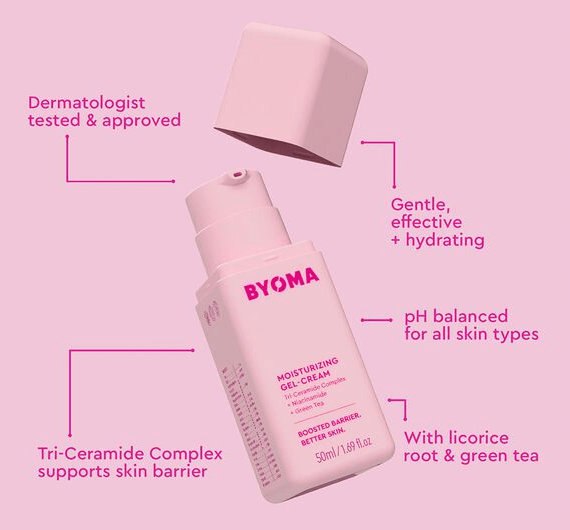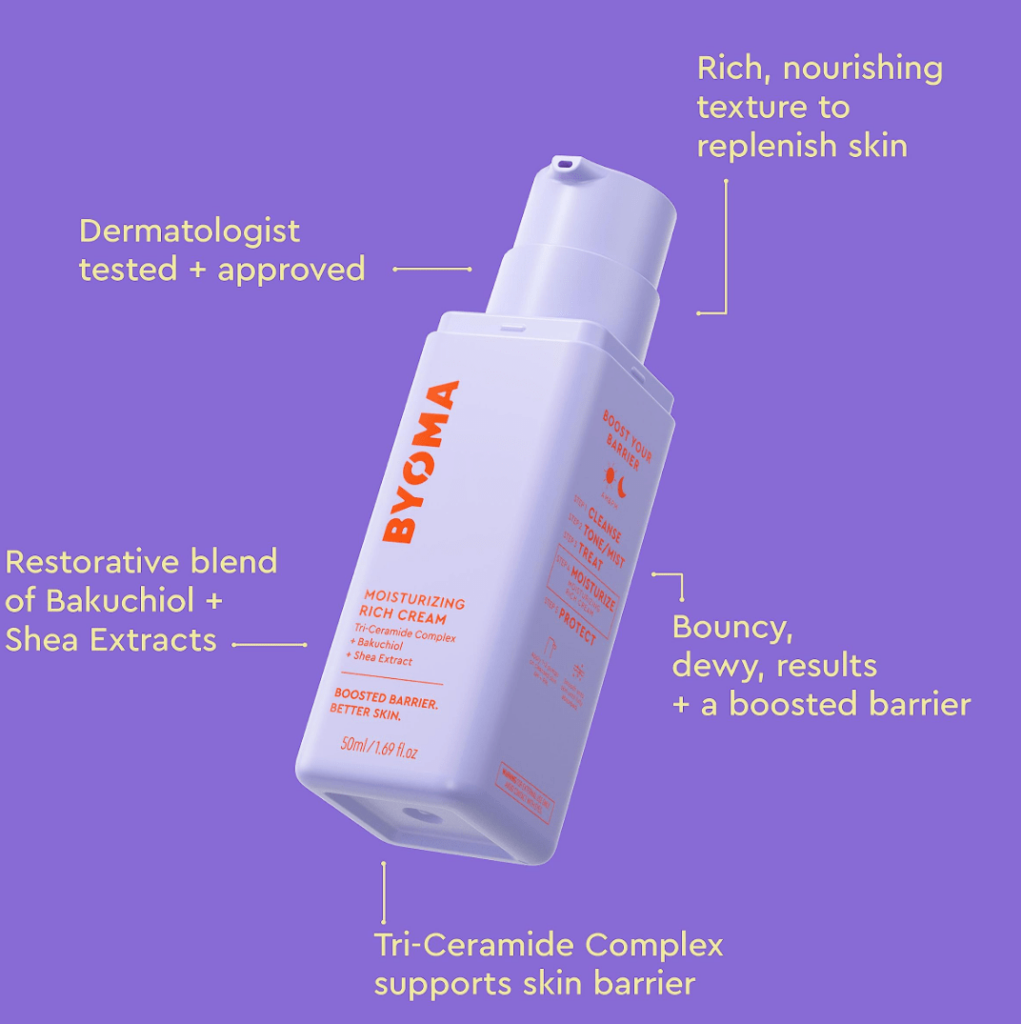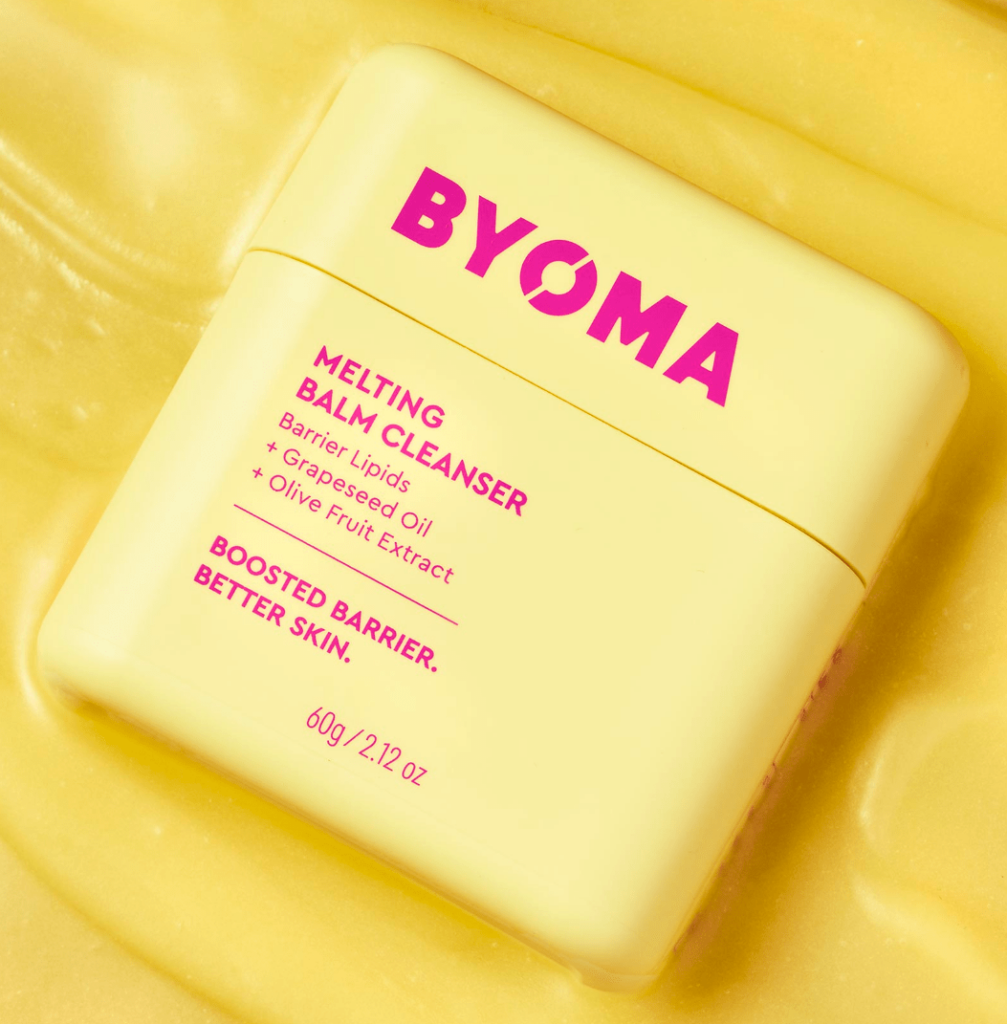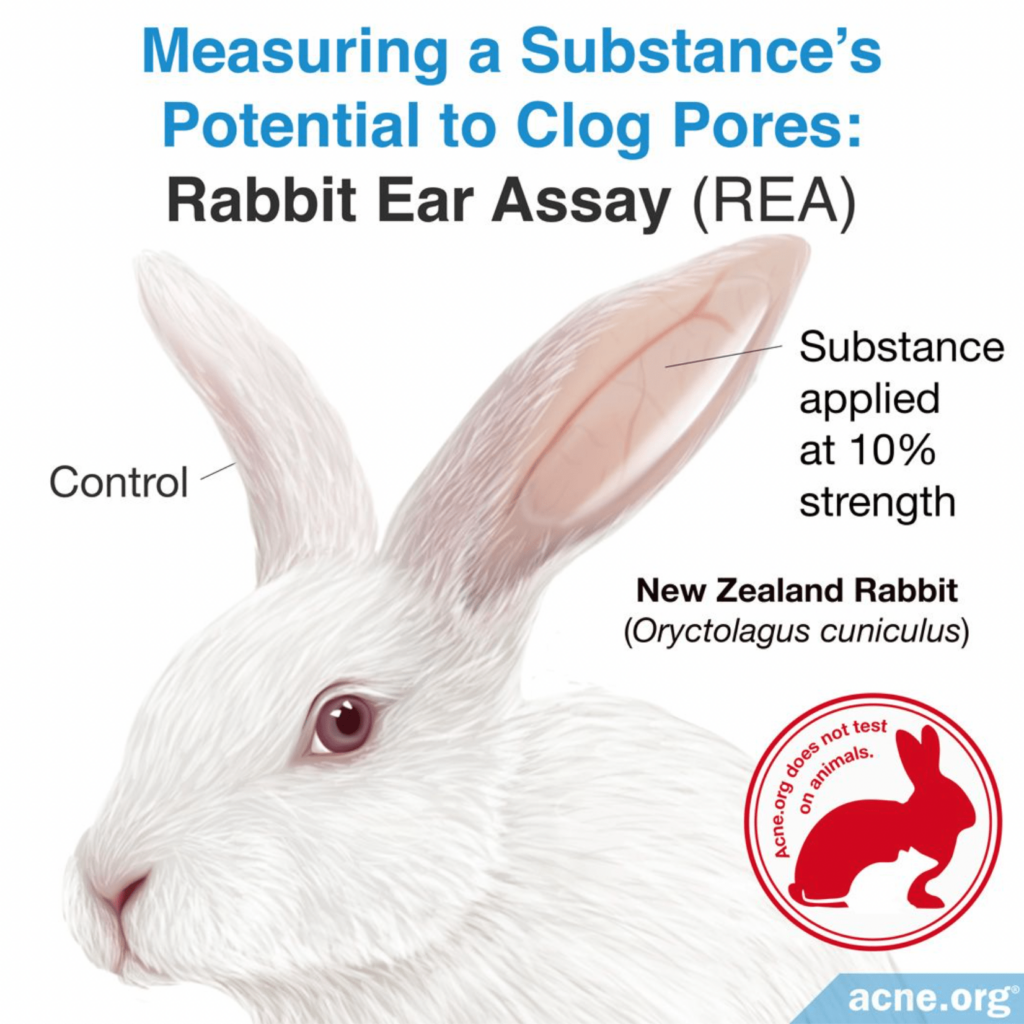This site contains affiliate links. I may earn a small commission, at no extra cost to you.
In this post I’ll share the best Byoma products for acne prone skin, along with the ones to avoid!
Disclaimer: When I link to the products I am using an affiliate link, which costs nothing for you. I am not currently affiliated with Byoma and this is a totally organic post.
Table of Contents
- The top 6 Byoma products for acne prone skin
- 3 Byoma products to avoid with acne
- The best Byoma products for kids and teens
- How to tell if a product is non comedogenic
- This was the Best Byoma Products For Acne Prone Skin
The top 6 Byoma products for acne prone skin

Byoma skincare products are the top selling brand in Boots UK at the moment.
They certainly have super fun packaging, but do the products actually live up to the hype?
These are the Byoma products for acne prone skin, based on what’s more and less likely to break you out.
1. Byoma Moisturising Gel Cream

Byoma’s Moisturising Gel Cream is a lightweight, oil-free moisturizer that provides effective hydration while supporting the skin’s natural barrier.
This product is favoured by Byoma fans with oily skin, who are concerned with clogged pores.
The moisturizing gel cream is a great choice for a moisturiser with a low likelihood of causing breakouts, overall.
Why this could work for your acne prone skin
This gel cream features Byoma’s Tri-Ceramide Complex, a blend of ceramides, cholesterol, and fatty acids, which work together to strengthen the skin barrier.
When you have acne it’s easy to neglect your skin barrier, but it’s actually super important for your overall glow.
It also contains niacinamide, which can calm inflammation and regulate oil production.
When to use this
I recommend using this under your sunscreen in the morning, or after your serums at night.
Check out my sunscreen post if you’re struggling to find a sunscreen for acne prone skin.
2. Byoma Phyto Glow Serum Review

Byoma’s Phyto-Mucin Glow Serum is a daily super-serum designed to hydrate, plump, and strengthen the skin barrier.
If you’re using actives like retinol or salicylic acid, a skin barrier serum is essential.
Moisturisers do take care of the skin barrier, but a separate skin barrier serum is an essential extra step in my opinion.
I made a YouTube video on the difference between barrier serums, hydrators etc, to help you understand things better.
This is a serum designed to mimic the snail mucin trend, but with plant based ingredients.
It’s the type of serum that’s perfect for sensitive skin, that you can use if you want more radiant skin.
Why this can work for your acne prone skin
This serum does nearly all things: moisturises, healing and strengthening.
A strong and healthy barrier is crucial for managing acne-prone skin.
Even though I recommend this generally speaking, unfortunately I started to notice some breakouts after a few weeks.
I still recommend it though, because what breaks me out may not break you out and visa versa. Our skins are all different.
When to use
You can use this morning and night, or just at night time.
You can use it after cleansing on damp skin, or after a retinoid or salicylic acid on dry skin.
Seal it in with a moisturiser afterwards – these are my moisturisers for clog prone skin recommendations.
3. Byoma Creamy Jelly Cleanser

Byoma’s Creamy Jelly Cleanser is a super hydrating, pH-balanced face wash that gently removes dirt and excess oil without compromising your skin barrier.
It’s incredibly gentle and contains their Tri-Ceramide Complex, plus antioxidant-rich licorice root and green tea extracts.
Altogether these keep your skin feeling hydrated instead of tight, but still cleans the skin well.
Why this can work for your acne prone skin
The best cleansers for acne prone skin are those that clean well, without stripping – the jelly cleanser nails this.
You may be tempted to go for an exfoliating cleanser, but I recommend avoiding those – here’s my YouTube video on why.
Licorice root extract helps to brighten and even out skin tone, while green tea extract provides anti-inflammatory benefits.
When to use
You can use this both morning and night, or just in the evening if you wish (I personally don’t cleanse in the morning).
In the morning, use it on its own. In the evening you can:
- Use after an oil cleanser as your second cleanser, if you like to double cleanse when you wear sunscreen and/or makeup.
- Use on its own if you prefer to single cleanse, or because you’re not wearing sunscreen/makeup that day.
I have some other recommendations for the best water based cleansers for acne prone skin.
4. Byoma Clarifying Serum

Byoma’s Clarifying Serum is a targeted treatment designed to balance and help clear the skin.
While I don’t feel this is likely to clear acne entirely, since it’s mostly hormonally driven, it can certainly help.
It contains both zinc and PHA. Zinc is especially interesting for acne prone skin as it’s anti inflammatory and antibacterial.
Bacteria plays a big part in acne breakouts, especially hormonal acne.
PHA is a very gentle exfoliant that can be used daily, but depends on what else is in your overall skincare routine.
When to use
Use this serum in either the morning or evening, I would not advise using it twice per day due to the exfoliating properties.
After cleansing, apply it to dry or damp skin, and before moisturising.
I would not combine this with a retinoid or another exfoliant at the same time.
5. Byoma Brightening Serum

The Byoma Brightening Serum is a great double whammy because it gently brightens and reduces oiliness, thanks to niacinamide.
As well as brightening, it helps hydrate with a mix of ceramides and hyaluronic acid.
I find a serum a lot less messy to use than a brightening toner, for example.
Why this can work for your acne prone skin
Niacinamide helps fade dark spots and post-inflammatory hyperpigmentation, a common concern for acne prone skin types.
While you’re getting the acne under control, you’ll want something to even out your skin tone, too.
When to use
You can use this serum twice a day, or just once per day because it’s hydrating, not exfoliating.
I recommend using it after cleansing and before moisturiser, on dry or damp skin.
6. Byoma Hydrating Serum

The Byoma Hydrating Serum is very similar to the Byoma Brightening Serum, but without niacinamide.
I know that’ll be music to the ears of people looking for serums without niacinamide!
Whilst I personally love niacinamide, not everybody does.
This is a basic hydrating serum that contains Byoma’s signature Tri-Ceramide Complex.
Ceramides are essential fats within the skin that keep it resilient and hydrated.
It also contains squalane and glycerin in the lightweight formula for potent hydration.
When to use
Like most other hydrating serums for acne prone skin, you can use this up to twice a day if you like.
I recommend using it after cleansing, before moisturiser.
3 Byoma products to avoid with acne

I said I’d give you the best and worst Byoma products for acne prone skin!
What causes breakouts for each person is extremely person, but these are the ones I’d swerve to avoid Byoma breakouts.
1. Byoma Moisturising Rich Cream

Byoma’s Moisturizing Rich Cream is designed to provide deep hydration and protect the skin barrier – I hear it is very effective for this.
Unfortunately, its rich formulation includes ingredients like shea butter which can be a red flag for me when it comes to breakouts.
It’s important to stress that this doesn’t mean it’s a bad product at all, just that some skin types are less tolerant of it.
2. Byoma Melting Balm Cleanser

Byoma’s Melting Balm Cleanser is generally well liked and may do a good job of cleansing.
However, as with all oil and balm cleansers, it can be a tricky line to tread with acne prone skin.
While harsh cleansers aren’t the answer for acne prone skin, I personally would avoid this balm cleanser.
Also, it contains an essential oil which can be irritating and cause acne-like breakouts, which I prefer not to use on my skin.
3. Byoma Barrier+ Treatment

Byoma’s Barrier Repair Treatment formula helps to restore and strengthen the skin barrier.
Despite its benefits, the rich consistency and inclusion of ingredients like avocado oil and shea butter may be too heavy for acne-prone skin.
Also, you can get plenty of barrier-boosting ingredients that are less clogg-y in some of their lighter serums (above).
For better suggestions, check out my list of the best skin barrier serums for acne prone skin.
The best Byoma products for kids and teens

Byoma for tweens is a good choice, in my opinion, as long as they stick to the hydrating products.
I would recommend the same Byoma products for young skin as I have for acne prone skin, from this list.
For more skincare brands for teens, check out my list of child friendly skincare brands.
How to tell if a product is non comedogenic

As you can see, the best Byoma products for acne prone skin are those with nourishing ingredients that aren’t overly heavy on the skin.
While a heavy product doesn’t automatically equal breakouts, it is a common trait of products that do cause breakouts.
What I think is really important to understand here, is that pore clogging ingredients and non comedogenic ingredient checkers are inaccurate.
The comedogenic ratings that ingredients have are inherently flawed and can’t guarantee a product won’t break you out.
Origins of the comedogenic scale

The comedogenicity scale was created by testing ingredients on rabbit ears.
They assumed the results would mirror human skin reactions – but obviously we’re not rabbits so that’s far from the case!
The list of comedogenic ingredients hasn’t been updated or re-tested in a long time, it’s really very archaic.
Modern testing has shifted to human subjects, often applying ingredients to the skin on participant’s backs.
Even so, the skin on our backs is not the same as our face.
Why singling out ingredients doesn’t work
The comedogenicity of an ingredient can vary based on its concentration, the overall formulation, and individual skin types.
So an ingredient deemed ‘comedogenic’ on its own might not have the same effect when part of a complex product formulation.
Why do brands label products ‘non-comedogenic’?

Given the inconsistencies and limitations in testing methods, the label “non-comedogenic” isn’t a guarantee that a product won’t clog pores for everyone.
In the US, the FDA doesn’t even regulate this term: any brand can claim their product is non comedogenic.
This was the Best Byoma Products For Acne Prone Skin
Byoma offers fantastic options for hydration, skin barrier support, and brightening – but not every product in their line-up is suitable.
My best tips would be:
- Prioritise lightweight formulas and using less > more
- Remember that labels like “non-comedogenic” aren’t foolproof (mostly ignore them!)
- Only try one new product at a time, so you easily identify what’s breaking you out
- Patch test new products on one cheek when introducing them, so you can compare sides
You may also like:
- How to create a Korean skincare routine for acne prone skin
- How to Use Retinol for Beginners: Step-by-Step Guide